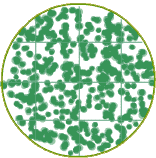Why we need to dilute
Let's say a culture contains about a million CFUs. At 1 CFU per second, that would take 11.6 days to count. Assuming you didn't stop to eat or sleep.
Clearly a better way is needed.
And clearly, this module is going to pick that method apart and pound it into the figurative whiteboard.
So let's get started already.
First of all, we're going to use the Viable Plate Count method -- the only method that can tell a live cell from a dead one (for a rundown on counting methods, look here). So, we're going to take a little bit of our culture, put it on a plate, and grow it up. But we still have a problem -- too many colonies to count. For example, even 500 colonies on a petri dish would look something like this:

What if you are trying to count a population in the thousands or millions? You could literally have a carpet of colonies (also known as a 'confluent lawn') growing on your petri dish. This is where dilution saves the day. Not just dilution, but serial dilution... meaning dilution over and over again.
Why do we dilute? To have less to count
Why do we do it repeatedly? Because we don't know how much dilution we need. Every time we dilute, we'll also make a new plate to incubate. So we might do 5 dilutions and grow up 5 plates. Then we'll end up throwing away 4 of them. Sound wasteful? Well, dilution and plating is quick and easy compared to the pain of starting your experiment all over again.
Copyright University of Maryland, 2007
You may link to this site for educational purposes.
Please do not copy without permission
requests/questions/feedback email: mathbench@umd.edu